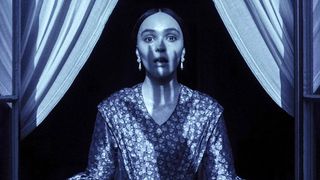Seeing F.W. Murnau’s 1922 classic silent film “Nosferatu” for the first time is a rite of passage for horror fans, and it can be eye-opening to realize how many key building blocks of the genre were established more than 100 years ago. It’s an immersive experience, especially for anyone who gets to see it with live musical accompaniment — as I did several years ago — making it even more powerful.
“Nosferatu” clearly made a strong impression on filmmaker Robert Eggers, who’s been talking about remaking it since the success of his 2015 debut film “The Witch,” and his new version (opening in theaters on Christmas Day) is nearly as mesmerizing as Murnau’s.
Murnau was actively participating in the early invention of cinema, so there’s no way for Eggers to match that level of innovation and wonder, but he captures the otherworldly sense of glimpsing something genuinely horrific while making some darker, gruesome updates.
Eggers’ film follows the plot of the original fairly closely, and both are freely adapted from Bram Stoker’s landmark vampire novel “Dracula,” which has become an indelible part of pop culture. So the general outline of “Nosferatu” will be familiar even to casual horror fans, but as is always the case with Eggers, his film stands out thanks to its rigor and formalism.
‘Nosferatu’ adds stylish flourishes to its well-known story
NOSFERATU - Official Trailer [HD] - Only In Theaters December 25 - YouTube
![NOSFERATU - Official Trailer [HD] - Only In Theaters December 25 - YouTube](https://img.youtube.com/vi/nulvWqYUM8k/maxresdefault.jpg)
Eggers’ film opens with a prologue that establishes newlywed Ellen Hutter (Lily-Rose Depp) as its true main character, centering her in a way that neither Murnau’s original nor Werner Herzog’s excellent 1979 version “Nosferatu the Vampyre” ever did. Young Ellen invokes a demonic presence to convene with her, thus setting in motion the eventual return of the ancient vampire Count Orlok (Bill Skarsgård).
Right from these opening moments, Eggers taps into something primal and disturbing, as he did with the colonial-era horror of “The Witch.” Depp adds to that with her visceral performance, as Ellen is consumed by the evil spirit that never truly leaves her.
A title card indicates a time jump to “years later,” with Ellen now married to mild-mannered clerk Thomas Hutter (Nicholas Hoult). Eggers retains the original setting of 1838 Germany, although it might as well be a fantasy world, given the way he infuses it with mysticism and mystery.
Eggers is known for the fastidious period details of his films, recreating the lives of Puritans in “The Witch” and Vikings in “The Northman.” While “Nosferatu” feels similarly authentic, it’s more about reflecting the Gothic fiction of Stoker and the German Expressionism of Murnau than about painstaking historical accuracy.
Once Thomas is called away to the remote castle of Count Orlok, “Nosferatu” leaves the realm of the tangible and comprehensible, anyway, as Thomas is held captive by the repulsive, menacing Orlok.
Actor Max Schreck’s performance as the original Orlok is so iconic that it’s nearly impossible to recreate without coming off like a parody, and Skarsgård makes the character his own without straying too far from what audiences expect. His Orlok is recognizably pale and mostly bald, with a pointed nose and ears and long pointed fingernails, but Skarsgård adds a bushy mustache and speaks in slow, guttural tones that make it sound like he’s dragging every word up from the depths of Hell.
‘Nosferatu’ is truly, deeply unsettling

As monstrous as Skarsgård is as Orlok, Depp is the one who gives “Nosferatu” its terrifying core, as Ellen undergoes seizures and sleepwalking spells in anticipation of Orlok’s arrival. She’s physically unrestrained in the manner of classic horror performances like Linda Blair in “The Exorcist” and Isabelle Adjani in “Possession.”
The men in Ellen’s life, including Thomas, his wealthy friend Friedrich Harding (Aaron Taylor-Johnson) and well-intentioned physician Dr. Wilhelm Sievers (Ralph Ineson), are powerless in the face of her fits and visions.
That feeling of powerlessness extends out to the entire town, which Eggers presents as a place almost cut off from the world, especially once Orlok arrives on a boat filled with plague-infested rats. Like Murnau, Eggers makes masterful use of shadows, and the most haunting image in the movie depicts the massive shadow of Orlok’s misshapen hand covering every corner of the town. He is inescapable, and all that the characters can do is briefly hold him at bay.
Herzog embraced that bleakness in his version, and while Eggers isn’t quite so nihilistic, there’s still a tragic arc to Ellen’s character. There’s also dark humor courtesy of Eggers regular Willem Dafoe as the eccentric Prof. Albin Eberhart Von Franz, an occult scholar who seems almost giddy at the prospect of tackling an unknowable evil force like Orlok.
As gloomy and oppressive as “Nosferatu” can be at times, it’s also consistently entertaining, and it may be Eggers’ most accessible film to date. He’s honored the horror tradition of being swept away by “Nosferatu,” while making a film that’s distinctly his own.
More from Tom's Guide
- I saw 105 movies in theaters in 2024 — here's the 10 best and 10 worst
- 'Mufasa: The Lion King' and 'Sonic 3' both just hit theaters — but only one's worth watching on the big screen
- When could "Wicked" come to streaming? Here's our best guess





















 English (US) ·
English (US) ·